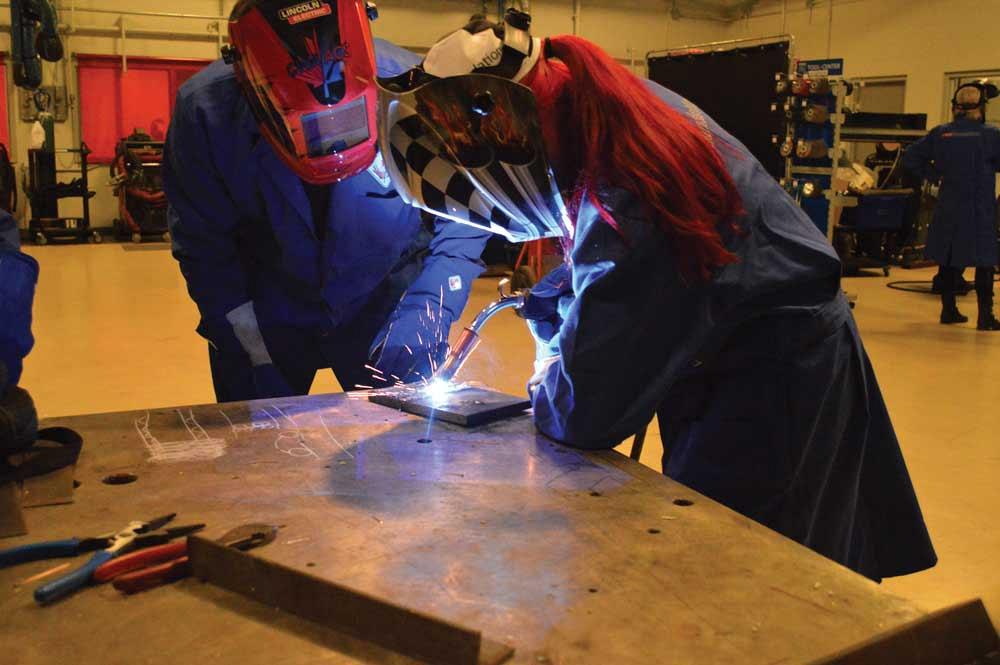Editor
- FMA
- The Fabricator
- FABTECH
- Canadian Metalworking
Acorn welding program makes strides in secondary schools
As the program takes root at high schools, colleges are also seeing value in the Canadian-made learning modules
- By Rob Colman
- January 17, 2017
- Article
- Welding
In May 2015 the CWB Group, Canada's national welding certification body, launched Acorn, the first nationally available welding program in Canada. The Acorn program provides educators at both the high school and post-secondary levels with modules through which they can offer students a streamlined and immersive welding education. Now, through the CWA Foundation, the program has been adopted for secondary schools at the provincial level in some provinces and at the board level in a variety of cities elsewhere. In late 2016 it was announced that the program is being put in place widely in high schools in New Brunswick, Nova Scotia, Manitoba, British Columbia, and Alberta. Gradually the program is creating a standard for welding education at the high school level.
High School Buy-InThe modules include a fairly comprehensive kit of tools with which to support the learning process: slides to use in a classroom mirrored by interactive online content for additional student support; online and hardcopy texts for students to review, some of which also include videos that clearly demonstrate important points; online quizzes to help students review concepts; and suggestions for in-shop exercises with which to engage students.
“The fact that Acorn is being adopted at the ministry, school district, or board level in these provinces is great for us because it gets the program out there quicker,” said Deborah Mates, executive director of the CWA Foundation. The CWA Foundation provides the Acorn program free of charge to secondary schools.
“What we are finding is that the teachers are really excited, because for a long time they didn’t have the resources they needed,” said Mates. “They were pulling information from here and there, but they didn’t have material that was current or that reflected state-of-the-art industry practices. The tools we have in Acorn are much more interactive.”
The program also offers teachers a better grounding in welding than they might otherwise have had. As Mates pointed out, a high school teacher may have trained as a millwright or auto mechanic, so although he or she has a working knowledge of welding, understanding how to best teach the process is a different story.
To facilitate this, the CWA Foundation has two staff members who run train the trainer sessions with teachers. These are either two- or four-day sessions through which they are able to give teachers the tools and the confidence to effectively use the Acorn modules.
Beyond these tools, the foundation is also working with schools across the country to get them better equipped to teach welding.
“Last year alone we worked with 48 schools in Canada to improve the actual shop space, improving the ventilation and the welding technology they have available for students to use,” said Mates. “We are going to be tripling that number this year. We are working with industry to get the schools the gases they need, the protective equipment, and other technology.”
Bruce James, who works in certification services at CWB Group, is one of the key developers of the Acorn program. As he sees it, the value proposition is quite simple for secondary schools.
“The program offers students a seamless transition into post-secondary or continuing education programs,” James explained.
College OpportunitiesAt this point the Acorn program has fully developed content for foundational and intermediate welding levels – essentially secondary school courses and courses that would cover the first year of a welder’s three-year apprenticeship.
“We are now working on the next phase of the program, the more complex learning outcomes,” said James. “This includes levels two and three for welders, and also complete modules for metal fabricator and fitter programs. We need graduates in those areas as well.”
Early adopters at the college level are pleased with what they are gaining from the use of Acorn.
Ken Underhill is program coordinator/welding professor at Mohawk College in Stoney Creek, Ont. Mohawk is in the process of updating its welding capabilities, bringing in more gas lines and investing in new equipment so that they can run both constant-current and constant-voltage welding machines. Around 3,000 students come through the welding shop in a year, including apprentices, ancillary trades, and students in Mohawk’s one-year program called Mechanical Techniques (Welding and Fabrication), which accepts 20 students a year currently.
Underhill was introduced to the Acorn program through the CWA Foundation’s annual National Educators Conference, where he received Acorn training and certification. He had nothing but positive things to say about his experience with it since his college implemented it for the first time in September 2016.
“The theoretical information is up-to-date with essential images, and the 3-D visualizations are phenomenal,” Underhill said. “Students can see them up on a screen in the classroom or they can follow along on their laptops or smartphones, so it is really flexible that way.”
Mohawk engages about six part-time instructors to fulfill the needs of welding students and the various ancillary trades that require a grounding in welding, including millwrights and plumbers. Underhill thinks that Acorn helps those instructors a great deal.
“It used to be that you would have to spend a great deal of time creating your own slide presentations and course notes, gathering material from a variety of textbooks,” Underhill explained. “Now when we have a new teacher start, they don’t have to spend months and months trying to bring their own perspective of what the curriculum needs. Being a part-time instructor can be difficult because they are not sure where to start.”
Underhill thinks that, at this stage, instructors will likely use Acorn as a basis for their classes, and supplement that material as they wish. But at least the program offers a consistent basis for learning.
Underhill was particularly impressed by 3-D visualizations of the five different types of welding joints.
“We can rotate the image and properly show the students the position we are in and make the learning process more interactive,” he said. “And the student has the same material that we do and can spend time before class looking through examples, or even go through it during class to follow along and better understand the concepts being discussed.”
Underhill pointed out that Acorn also suggests exercises for the shop, depending on the level of the welding students.
In the future Underhill hopes that using this content will help the welding department expand the blended learning approach, such that less time is spent on campus in the classroom and more time is spent in the shop doing actual welds. Because all of the material is available to students on an e-learning platform, this should be possible. It’s simply a matter of getting both students and instructors familiar with the process.
Canadian ContentRobbie Duncan is the welding program coordinator at Cambrian College in Sudbury, Ont. Beyond its support of other programs and apprenticeships, the college also offers a two-year welding course. Duncan hasn’t yet used the Acorn program because he teaches a higher-level curriculum that is not yet supported. The college is using Acorn in its welding theory, drawing interpretation, and shop practices courses.
Duncan said there have been some growing pains with the adoption of the program and how it interacts and is different than the open-source learning platform the instructors currently use as far as having control of the way tests and quizzes are given. But he also said that the CWB has been very good in helping faculty with any issues they are having.
“What the program gives us to work with is all Canadian content, which is great,” said Duncan. “It’s very generic, so they are not focused on individual suppliers or companies, and you can see that in their presentations.” Duncan also noted that the online content has speech embedded into it so students that have any difficulty reading can have the text read out to them.
At Cambrian, they are really trying to use it as a study aid for students.
“We want them to look at certain sections or questions ahead of time so that when they do come to class, faculty can reinforce what they have already reviewed,” said Duncan. “Honestly, there is enough material in the modules that this could be a stand-alone tool if someone wanted to learn independently of a class.”
Still, Duncan doesn’t think the program threatens instructors.
“They are enhancing anything that we could possibly do with our limited budgets and time,” he said. “Right now we are using Acorn as a resource instead of some of the textbooks that we used to use. It’s an opportunity to teach students differently.”
The program may yet help to create a more consistent welding education across the country in the process and prove to be a model for other trades.
About the Author

Rob Colman
1154 Warden Avenue
Toronto, M1R 0A1 Canada
905-235-0471
Robert Colman has worked as a writer and editor for more than 25 years, covering the needs of a variety of trades. He has been dedicated to the metalworking industry for the past 13 years, serving as editor for Metalworking Production & Purchasing (MP&P) and, since January 2016, the editor of Canadian Fabricating & Welding. He graduated with a B.A. degree from McGill University and a Master’s degree from UBC.
subscribe now


Keep up to date with the latest news, events, and technology for all things metal from our pair of monthly magazines written specifically for Canadian manufacturers!
Start Your Free Subscription- Trending Articles
BlueForge Alliance partners with Nuts, Bolts & Thingamajigs to develop Submarine Manufacturing Camps

Portable system becomes hot tech in heat treatment

Orbital tube welding webinar to be held April 23

Cidan Machinery Metal Expo 2024 to be held in Georgia May 1-2

Corrosion-inhibiting coating can be peeled off after use

- Industry Events
MME Winnipeg
- April 30, 2024
- Winnipeg, ON Canada
CTMA Economic Uncertainty: Helping You Navigate Windsor Seminar
- April 30, 2024
- Windsor, ON Canada
CTMA Economic Uncertainty: Helping You Navigate Kitchener Seminar
- May 2, 2024
- Kitchener, ON Canada
Automate 2024
- May 6 - 9, 2024
- Chicago, IL
ANCA Open House
- May 7 - 8, 2024
- Wixom, MI
















